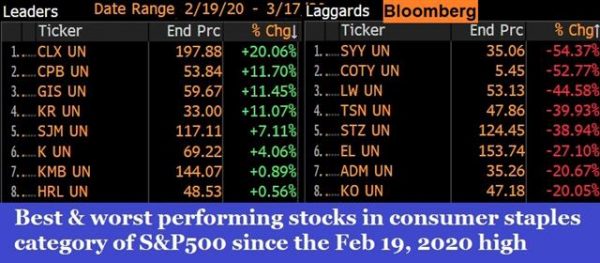Monday’s bazooka from the Federal Reserve fizzled and on Tuesday Treasury Secretary Mnuchin and other finance ministers fired theirs. The initial results were better with a modest bounce in risk, but there are good reason to think this will fizzle as well. Futures are already down 4%, US crude oil is below 27 and gold above 1540. The US dollar climbed across the board earlier on Tuesday, as the funding squeeze continues. Moments ago, Ashraf has issued a 3rd Premium trade, backed by charts & supporting notes. Below are the best and worst performing stocks of the S&P500’s consumer stapes sector since the high.
The fiscal plans that are leaking out of the White House and Congress to fight the virus comprise astonishing numbers. The latest is a $1.2 trillion program that will include direct payments to Americans of about $2000 along with business backstops.
That dwarfs the $700B crisis-era TARP bailout. It would be a shock if we didn’t exceed the $1.4T crisis-era deficit this year. It could be triple as revenues collapse on the slowdown.
The bailouts could also balloon the number. Yesterday there was talk of a $50B airline loan, today Boeing is seeking a minimum of $60B in liquidity after drawing down its credit lines. Shares of the company are down more than 70% in a month.
The long-end of the US Treasury curve pushed much higher Tuesday and that’s probably due to forced selling for liquidity but the wave of issuance coming is another reason to worry. It’s not just the US, Spain unveiled plans for up to 200B, which would be 15% of GDP.
Again, much of that is in credit backstops but every big business bailout demands a small business bailout. In turn that demands a consumer bailout, and it’s banks that are holding all the bad loans.
To illustrate, there are $1.2 trillion in low-grade leveraged loans in the US. Those are trading at 84-cents at the moment. Shale companies have $300B in bank debt and virtually all of the companies are on borrowed time with WTI at $26.
The deeper you look, the more daunting it appears.
Even more daunting are the growing political concerns. There is some level of belief in markets that both sides in the US can come together but that’s rarely a good bet. Some Democrats are pushing for a higher minimum wage, bans on buybacks and zero dividends. Some Republicans have other priorities.
In FX, the dollar funding squeeze continues despite the swap lines. That argues for severe stress in the financial system despite dramatic Fed actions. They added to that with a 90-day loans to primary dealers backed by collateral as flimsy as stocks. That’s a sign of panic and something far worse than even the drastic declines in stocks are pricing in.














